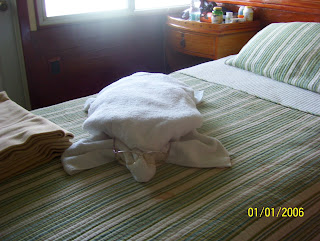http://www.worldatlas.com/webimage/countrys/samerica/lgcolor/gpcolor.htm
The next day we went by bus up into the highlands of Santa Cruz. This is where the big land tortoises live, and their habitat is a national park. Again, we didn't see a lot of them, and we wasted a tremendous amount of time watching people trying to get into, and move around in, a toroise shell, minus the original occupant. One or two would have been sufficient, really. This was the cutest.

So then we started hiking all over to look for them. Joyce went, too! We had our walking sticks, as always. The light conditions for tortoise-picture taking weren't the best, because they go under the bushes, but I caught one out in the open.
Franklin said they may be slow (They certainly are!) but they can cover three miles or more a day, especially when highly motivated by things like mating. We watched a slow-motion chase that went on the whole time we were there without reaching resolution. He was bigger but she was faster. And did you know that turtles (land or marine, any size or species) can't die of old age? They can only die of disease, injury or predation. They know these creatures are hundreds of years old, but exactly how old, they can't tell. You can assume at least some of them, the ones who hid well and weren't eaten by humans, were around when Darwin visited. They date the ones that are born now, but as far as the ones already there, no clue.
Anyway, it finally got too hot for hiking so we got back on the bus and went to a lava tube. That was down a lot of steps, again with no railings, and sounded too messy with not enough payoff, so we passed on that. Then we returned to Puerto Ayora to panga out to the boat for lunch. Even though this was a built-up area, it has the most beautiful water I've ever seen. Franklin says it has to do with the algae and the depth and the position on the equator. I mean, look at this.


And then when we got back on the boat, there was a tortoise in our cabin!

 And neighbors. This is a land iguana. All the dark ones are the marine type. There's one island where they mix and you can see some hybrids, maybe.
And neighbors. This is a land iguana. All the dark ones are the marine type. There's one island where they mix and you can see some hybrids, maybe.After the Research Center, they told us it was just a mile back into town. Yeah, over broken sidewalks in 98 F. No thanks. We called a cab. Then one of the pangas was down for maintenance so we all crammed into one. It was a long, low ride, but the water was beautiful!
At the dock, we said goodbye to our gaggle of backpackers. That makes this a good place to discuss some things we learned about how Ecuadorans view their guests from around the world. Americans, Canadians, Australians and and Kiwis are all welcomed with open arms. However, they HATE Western Europeans, thinking they're a bunch of arrogant, useless slobs. Oddly, the British are not included as "Europeans" although we USAians often group them together. British people are lumped in with Canadians and Americans for Ecuadoran purposes.
Of all the Europeans, they hate the Germans most. And right up there with the Germans are the Argentineans, the Texans of South America. They apparently never shut up about how big and rich they are. Ecuadorans and Peruvians don't like that. This year, lacking a team in the World Cup, Ecuador is cheering for Brazil, Argentina's arch-enemy. That's all for today's lesson on prejudice around the world. Seems like we all have them.
Next: Hide! Hide! They're refuelling outside!

No comments:
Post a Comment